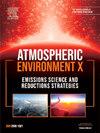畜禽密集区不同畜牧生产动物对分散模拟环境氨和颗粒物的贡献
IF 3.4
Q2 ENVIRONMENTAL SCIENCES
引用次数: 0
摘要
畜牧业生产排放的氨(NH3)和初级PM10影响健康和生物多样性,因此减少它们至关重要。不同家畜种类的NH3和PM10排放量存在差异,可能导致不同区域NH3和PM10的空间分布格局。这使制定有效的缓解战略变得复杂。本研究旨在揭示不同畜牧业生产动物对NH3和PM10空间格局的影响。研究区域面积约40 x 50 km2,包括荷兰一个牲畜密集区,约2000个农场,几个住宅区和自然公园。使用基于农场排放的分散模型,预测了100 x 100 m2网格上约100,000个受体点的空间浓度模式。通过敏感性分析评估模型假设。畜牧业生产排放显著增加了当地的NH3水平,而PM10水平则略微升高。农场和牲畜种类的地理空间分布强烈地驱动了空间浓度格局,在农场密集聚集的地区观察到浓度升高。农场对总NH3浓度在受体点的贡献分布的特征是来自研究区域内多个农场的大量小贡献。研究区的农村地区的浓度较高,其特点是这些小贡献与附近农场的一些大贡献相结合。将农场纳入广泛的半径范围对于模拟自然地区NH3浓度尤为重要。这些研究结果表明,应该对牲畜养殖场排放的普遍减少进行调查,以制定缓解战略。本文章由计算机程序翻译,如有差异,请以英文原文为准。
Contributions of different livestock production animals to dispersion-modelled ambient ammonia and particulate matter in a livestock-dense area
Ammonia (NH3) and primary PM10 emitted by livestock production affect health and biodiversity, making their reduction essential. Quantities of emitted NH3 and PM10 vary across different livestock species, potentially leading to different regional spatial patterns of NH3 and PM10. This complicates the development of effective mitigation strategies. This study aims to provide insight into how different livestock production animals affect spatial patterns of NH3 and PM10.
The study area of ∼40 x 50 km2 encompassed a livestock-dense area with ∼2000 farms, several residential clusters and nature parks in the Netherlands. Spatial concentration patterns were predicted for ∼100,000 receptor points on a 100 x 100 m2 grid using a dispersion model based on farm emissions. Model assumptions were evaluated through sensitivity analyses.
Livestock production emissions significantly increased local levels of NH3 and more moderately elevated local levels of PM10. Spatial concentration patterns were strongly driven by geospatial distributions of farms as well as livestock species, with elevated concentrations observed in areas where farms were densely clustered. The distribution of farm contributions to total NH3 concentrations at receptor points was characterized by numerous small contributions from multiple farms across the study area. Concentrations were higher in rural parts of the study area and characterized by the combination of these small contributions with a few large contributions from nearby farms. Inclusion of farms in a wide radius was especially important for modelling NH3 concentrations in nature areas. These findings imply that generic reduction of livestock farm emissions should be investigated for the formulation of mitigation strategies.
求助全文
通过发布文献求助,成功后即可免费获取论文全文。
去求助
来源期刊

Atmospheric Environment: X
Environmental Science-Environmental Science (all)
CiteScore
8.00
自引率
0.00%
发文量
47
审稿时长
12 weeks
 求助内容:
求助内容: 应助结果提醒方式:
应助结果提醒方式:


